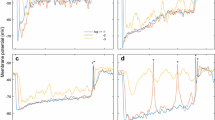Summary
The organization, characterization and connectivity patterns of four different interneurone types were studied with the use of Golgi light- and electron-microscopic techniques. All four cell types originate in the outer chiasma; they have an efferent end-branch in the lamina and an afferent one terminating in the distal region of the second optic ganglion, the medulla. These interneurones are referred to as:
(i) Garland-cell: The efferent fibre has on its tangential branch numerous centripetal side branches, so-called “garlands”, which synapse with first- and second-order visual cells. (ii) Y-cell: The lamina branch bifurcates before entering the lamina. It innervates two neighbouring cartridges. Synaptic contacts were seen in two different laminar strata where bottle-brush-like collaterals occurred. (iii) Single bottle-brush cell: The efferent part has only one centrifugal branch, which can be compared morphologically and in terms of synaptology with those of the Y-cell. (iv) Triptychcell: The lamina component innervates three neighbouring cartridges at three different laminar layers interconnecting different first- and second-order visual neurones.
The present study provides some essential qualitative and quantitative fine-structural information, which — when compared with adequate physiological data — may lead to a better understanding of the function of the first visual information-processing centre of the bee.
Similar content being viewed by others
References
Arnett DW (1972) Spatial and temporal integration properties of units in the first optic ganglion of dipterans. J Neurophysiol 35:429–444
Braitenberg V (1970) Ordnung und Orientierung der Elemente im Sehsystem der Fliege. Kybernetik 7:235–242
Cajal SR (1904) Textura del sistema nervioso del hombre y del los vertebrados. Tomo II. Nicolás Noya Madrid pp 621–648
Cajal SR, Sanchez D (1915) Contribution al conocimiento de los centros nerviosos de los insectos. Parte I. Retina y centros opticos. Trab Lab Invest Biol Univ Madrid 13:1–168
DeVoe RD, Kaiser W, Ohm J, Stone LS (1982) Horizontal movement detectors of honeybees: Directionally-selected visual neurones in the lobula and brain. J Comp Physiol 147:155–170
Götz KG (1968) Flight control in Drosophila by visual perception of motion. Kybernetik 6:199–208
Götz KG (1972) Processing of cues from the moving environment in the Drosophila navigation system. In: Wehner R (ed) Information Processing in the Visual System of Arthropods. Springer, Berlin Heidelberg New York, pp 255–264
Hausen K (1976) Functional characterization and anatomical identification of motion sensitive neurones in the lobula plate of the blowfly Calliphora erythrocephala. Z Naturforsch 31c:629–633
Kolb H (1974) The connections between horizontal cells and photoreceptors in the retina of the cat: Electron microscopy of Golgi preparations. J Comp Neurol 155:1–14
Laughlin SB (1974) Neuronal integration in the first optic neuropile of dragonflies. II. Receptor signal interactions in the lamina. J Comp Physiol 92:357–375
Laughlin SB (1975) Receptor and interneuron light-adaptation in the dragonfly visual system. Z Naturforsch 30c:300–308
Ohm J (1981) Intrazelluläre Ableitungen aus Vertikal-Bewegungsdetektoren in der Lobula der Biene Apis mellifica carbuca. Verh Dtsch Zool Ges 1981:172
Ribi WA (1975) The neurons of the first optic ganglion of the bee, Apis mellifera. Adv Anat 50:41–43
Ribi WA (1976) The first optic ganglion of the bee. II. Topographical relationships of second order neurons within a cartridge and to groups of cartridges. Cell Tissue Res 171:359–373
Ribi WA (1979) The first optic ganglion of the bee. III Regional comparison of photoreceptor cell axon morphology. Cell Tissue Res 200:345–357
Ribi WA (1981) The first optic ganglion of the bee. IV. Synaptology of receptor cell axons and first order interneurones (a Golgi-EM study). Cell Tissue Res 215:443–464
Ribi WA (1983) Combined Golgi and electron microscopy techniques. In: Miller TA (ed) Experimental entomology, Vol II: Neuroanatomical techniques. Springer, Berlin Heidelberg New York pp 1–18
Strausfeld NJ (1970) Golgi studies on insects. Part II. The optic lobes of diptera. Phil Trans Soc B 258:175–223
Strausfeld NJ (1971) The organization of the insect visual system (light microscopy). I. Projections and arrangements of neurons in the lamina ganglionaris of diptera. Z Zellforsch 121:377–441
Strausfeld NJ (1976) Atlas of an insect brain. Springer, Berlin Heidelberg New York
Trujillo-Cénoz O, Melamed J (1970) Light- and electronmicroscope study of one of the system of centrifugal fibres found in the lamina of muscoid flies. Z Zellforsch 110:336–349
Zettler F, Järvilehto M (1972) Lateral inhibition in an insect eye. Z vergl Physiol 76:233–244
Author information
Authors and Affiliations
Rights and permissions
About this article
Cite this article
Ribi, W.A. The first optic ganglion of the bee. Cell Tissue Res. 236, 577–584 (1984). https://doi.org/10.1007/BF00217225
Accepted:
Issue Date:
DOI: https://doi.org/10.1007/BF00217225




